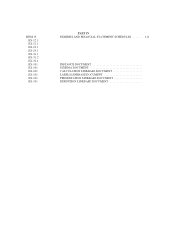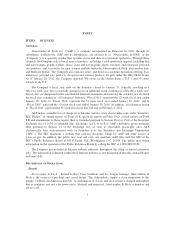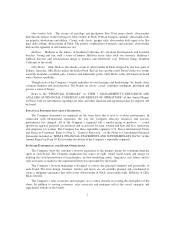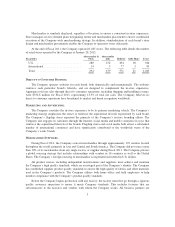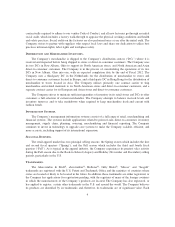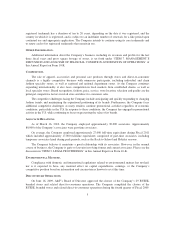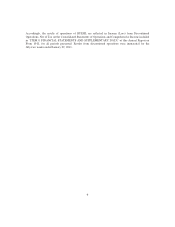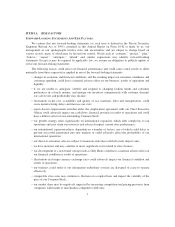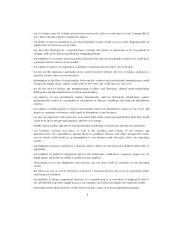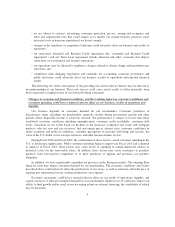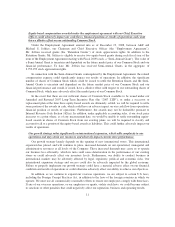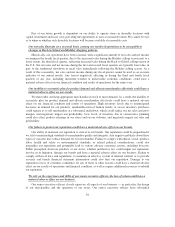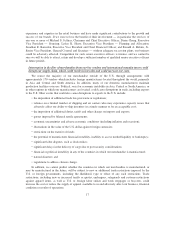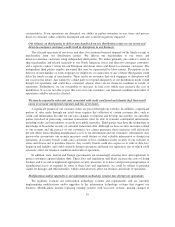Abercrombie & Fitch 2011 Annual Report Download - page 13
Download and view the complete annual report
Please find page 13 of the 2011 Abercrombie & Fitch annual report below. You can navigate through the pages in the report by either clicking on the pages listed below, or by using the keyword search tool below to find specific information within the annual report.
In addition, the economic environment may exacerbate some of the risks noted below, including
consumer demand, strain on available resources, international growth strategy, store growth, interruption of
the flow of merchandise from key vendors and manufacturers, and foreign currency exchange rate
fluctuations. The risks could be exacerbated individually, or collectively.
If we are unable to anticipate, identify and respond to changing fashion trends and consumer
preferences in a timely manner, and manage our inventory commensurate with customer demand, our
sales levels and profitability may decline.
Our success largely depends on our ability to anticipate and gauge the fashion preferences of our
customers and provide merchandise that satisfies constantly shifting demands in a timely manner. Our
merchandise must appeal to our consumers, whose preferences cannot be predicted with certainty and are
also subject to rapid change. We must translate market trends into appropriate, saleable merchandise far in
advance of its sale in our stores or through our websites. Because we enter into agreements for the
manufacture and purchase of merchandise well in advance of the applicable selling season, we are
vulnerable to changes in consumer preferences and demand, pricing shifts, and the sub-optimal selection
and timing of merchandise purchases. Moreover, there can be no assurance that we will continue to
anticipate consumer demands successfully in the future. To the extent we fail to anticipate, identify and
respond effectively to changing consumer preferences and fashion trends, our sales will be adversely
affected. Inventory levels for certain merchandise styles no longer considered to be “on trend” may
increase, leading to higher markdowns to sell through excess inventory or increases in inventory valuation
reserves. A distressed economic and retail environment, in which many of our competitors continue to
engage in aggressive promotional activities, particularly in the U.S., increases the importance of reacting
appropriately to changing consumer preferences and fashion trends. Conversely, if we underestimate
consumer demand for our merchandise, or if our manufacturers fail to supply quality products in a timely
manner, we may experience inventory shortages, which may negatively impact customer relationships,
diminish brand loyalty and result in lost sales. Any of these events could significantly harm our operating
results and financial condition.
Fluctuations in the cost, availability and quality of raw materials, labor and transportation, could
cause manufacturing delays and increase our costs.
Fluctuations in the cost, availability and quality of the fabrics or other raw materials used to
manufacture our merchandise could have a material adverse effect on our cost of goods, or our ability to
meet customer demand. The prices for such fabrics depend largely on the market prices for the raw
materials used to produce them, particularly cotton. The price and availability of such raw materials may
fluctuate significantly, depending on many factors, including crop yields and weather patterns. Such factors
may be exacerbated by legislation and regulations associated with global climate change.
In addition, the cost of labor at many of our third-party manufacturers has been increasing
significantly, and as the middle class in developing countries continues to grow, it is unlikely such cost
pressure will abate. The cost of transportation has been increasing as well and, if the price of oil continues
to increase, and there continues to be significant unrest in the Middle East, it is unlikely that such cost
pressure will abate.
We may not be able to pass all or a portion of higher raw materials prices or labor or transportation
costs on to our customers, which could adversely affect our gross margin and results of our operations.
10


